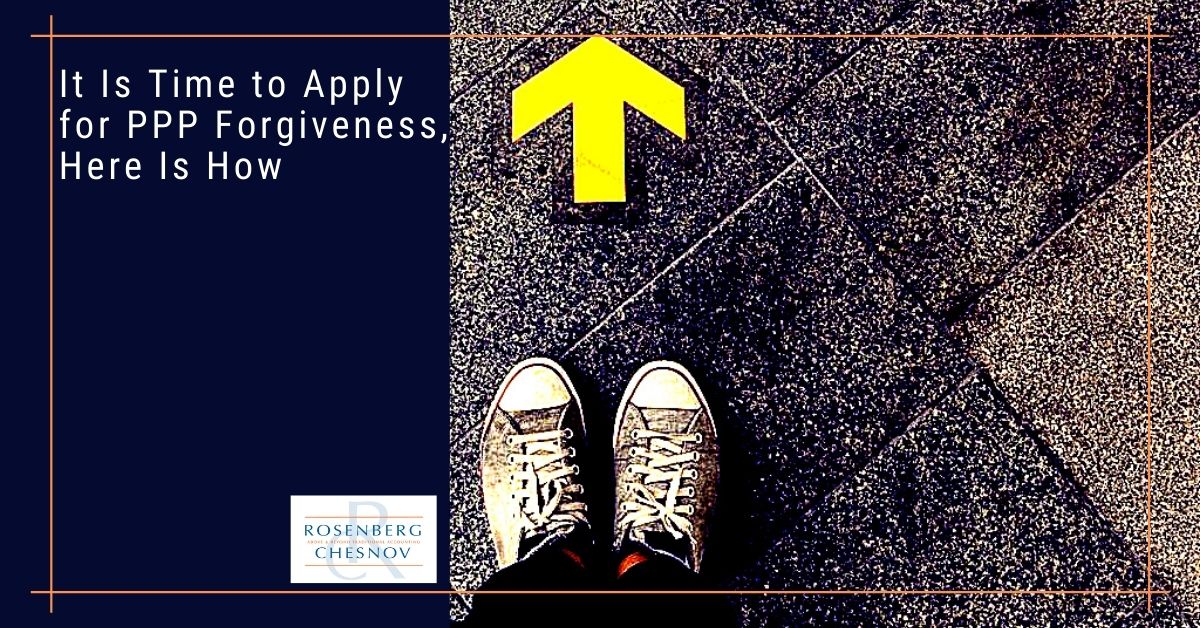

What does the Advance Child Tax Credit mean for you?
Category: COVID-19
Last week Congress passed, and the president signed HR7010, the Paycheck Protection Program Flexibility Act of 2020.
The Flexibility Act makes some significant changes to the Paycheck Protection Program (PPP), especially the loan forgiveness provision. On June 10, 2020, the Treasury Department issued their first changes to the PPP rules – these rules are the interpretation of the legislation and how it will impact us.
This update is based on the Treasury rules released on June 10 with some interpretation of the Flexibility Act itself. The analysis here is our best understanding of how the new rules will work – but there will likely be changes.
Also, remember that the challenge here is forgiveness. Any PPP amount that the SBA does not forgive becomes a loan at 1%.


The flexibility act did change the term of the PPP loan portion: it was two years now it is five. Also, the deferment period increased from 6 months to 10 months after the end of your “covered period.”
Note that if you received your PPP loan before June 5, 2020, your term is still two years until you agree with your bank to change the term. The rules say that you and your lender “may mutually agree to extend the maturity of such loans to five years.”
Any loan made after June 5, 2020, is automatically a five-year loan.
Regarding loan forgiveness here are the changes the Flexibility Act introduced to the PPP program, as we understand them today:
Covered period extended—The period to use loan money was 8 weeks; it is now 24 weeks (if you received your loan before June 5, you may elect to use the 8 weeks following the receipt of the loan, if you prefer).
This also changes the amount that you can pay employees. Whereas the maximum before was $15,385, extending the covered period to 24 weeks means that you can pay each employee $1,923/wk times 24 weeks = $46,153.
This has the added benefit of making it much easier to meet the minimum payroll threshold.
“Owner compensation replacement” rules apply to anyone who files a Schedule C, profit or loss from business or Schedule F, profit or loss from farming, tax return. Basically you are a sole proprietor, contractor, or single-member LLC.
The rules cap forgiveness for owner compensation at $15,385 over the 8-week covered period or 2.5 months of 2019 net profit up to a maximum of $20,833 over the 24-week covered period.
Social Security payments deferred—Originally under the Cares Act, employers who received the PPP Loan could not also defer employer social security tax payments. Now, any employer with social security payments due between March 27, 2020, and December 31, 2020, can pay half the amount due by the end of 2021 and the remainder by the end of 2022.
Loan payment deferral extended—The original 6-month deferral for repayment of PPP loans has increased to 10 months from the end of the covered period.
There is an additional extension: if you apply for forgiveness within the 10 months, you will not have to make any payments until the SBA remits the loan forgiveness amount to your lender or notifies your lender that no forgiveness is allowed.
Interest will accrue on the amount not forgiven.
Remember, you only make payments on the amount of the loan the SBA does not forgive.
Payroll threshold adjusted— the original rules required businesses to use 75% of the loan for payroll. The payroll minimum is now 60%. But the wording is also interesting because now 60% of the forgiven amount must be used for payroll.
So, if you spend $50,000 on payroll, the maximum amount of forgiveness you will qualify for is $50,000/.6 or $83,333, regardless of how much you borrowed.
Here is another example: Say your PPP loan was $100,000, and you spent $30,000 on payroll and $70,000 on other forgivable expenses. The maximum amount of forgiveness you can apply for is $30,000/.6 = $50,000. The remaining $50,000 will stay a loan.
Based on the forgiveness rule above, this means that the total forgiveness a sole proprietor, single-member LLC, or contractor can apply for is $20,833/.6 = $34,722. This may be an unintended consequence so we may see this change.
Restoring FTE’s not as strict — The CARES act initially required that you restore FTE’s before June 30, 2020. The new law changed that date to December 30. The rules around restoring FTE’s remain the same with one gaping exception.
The new rules say that
“if a borrower is unable to rehire previously employed individuals or similarly qualified employees, the borrower will not have its loan forgiveness amount reduced based on the reduction in full-time equivalent employees.”
Treasury Department Rules, June 10, 2020
Originally you had to prove that you made an offer, and the person receiving the offer refused it. Now, apparently, you just have to say that you were unable to hire people back. A lack of business seems like a valid reason.
This change is massive, and it seems to nullify the entire clause around retaining FTE’s.
The way the new application is worded there are two components to forgiveness related to FTE’s and payment.
I am pretty sure that almost every business will be able to qualify for an exception based on that second loophole.
Loan term date extended—As mentioned above, all new PPP loans made after June 5, 2020, will automatically have a 5-year term. Businesses that received a loan before June 5, 2020, can ask the bank to adjust the loan term from two to five years.
The new legislation significantly increases the flexibility of the PPP loan and will hopefully help you keep your business going through this crisis. Hopefully, this update helps.
If you are a client and would like to book a consultation, just click here.
If you aren’t a client, why not? We can take care of your accounting, bookkeeping and CFO needs so that you don’t have to worry about any of it. Interested? Click here for a no-obligation consultation.
Use the PPP loan to prepare for the future. Check out our webinar on the Six Things All Businesses Must Do Now for ideas.


Category: COVID-19


Category: COVID-19


Category: Accounting
Send us a message and we will contact you as soon as possible.
Send us a message and we will contact you as soon as possible.
Jeff Coyle, CPA, Partner of Rosenberg Chesnov, has been with the firm since 2015. He joined the firm after 20 years of business and accounting experience where he learned the value of accurate reporting, using financial information as a basis for good business decisions and the importance of accounting for management.
He is a diligent financial professional, able to manage the details and turn them into relevant business leading information. He has a strong financial background in construction, technology, consulting services and risk management. He also knows what it takes to create organizations having built teams, grown companies and designed processes for financial analysis and reporting.
His business experience includes:
Creating and preparing financial reporting, budgeting and forecasting.
Planning and preparation of GAAP and other basis financial statements.
Providing insight on financial results and providing advice based on those results.
Jeff also has a long history of helping individuals manage their taxes and plan their finances including:
Income tax planning and strategy.
Filing quarterly and annual taxes.
Audit support.
General financial and planning advice.
Prior to joining the firm in 2015, Jeff was in the private sector where he held senior financial and management positions including Controller and Chief Financial Officer. He has experience across industries, including construction, technology and professional services which gives him a deep understanding of business.
Jeff graduated from Montclair State University, he is a CPA and member of the American Institute of Certified Public Accountants, New York State Society of Certified Public Accountants and New Jersey State Society of Public Accountants.
Jody H. Chesnov, CPA, Managing Partner of Rosenberg Chesnov, has been with the firm since 2004. After a career of public accounting and general management, Jody knows the value of good financials. Clarity, decision making, and strategy all start with the facts – Jody has been revealing the facts and turning them into good business results for more than three decades.
He takes a pragmatic approach to accounting, finance and business. His work has supported many companies on their path to growth, including helping them find investors, manage scaling and overcome hurdles. His experience and passion for business reach beyond accounting and he helps businesses focus on what the numbers mean organizationally, operationally and financially.
He has a particular expertise in early-stage growth companies. His strengths lie in cutting through the noise to come up with useful, out of the box, solutions that support clients in building their businesses and realizing their larger visions.
Prior to joining the firm in 2004, Jody was in the private sector where he held senior financial and management positions including General Manager, Chief Financial Officer and Controller. He has experience across industries, which gives him a deep understanding of business.
Jody graduated with a BBA in Accounting from Baruch College, he is a CPA and member of the American Institute of Certified Public Accountants and New York State Society of Certified Public Accountants.
In addition to delivering above and beyond accounting results, Jody is a member of the NYSCPA’s Emerging Tech Entrepreneurial Committee (ETEC), Private Equity and Venture Capital Committee and Family Office Committee.
He is an angel investor through the Westchester Angels, and has served as an advisor for many startup companies and as a mentor through the Founders Institute.